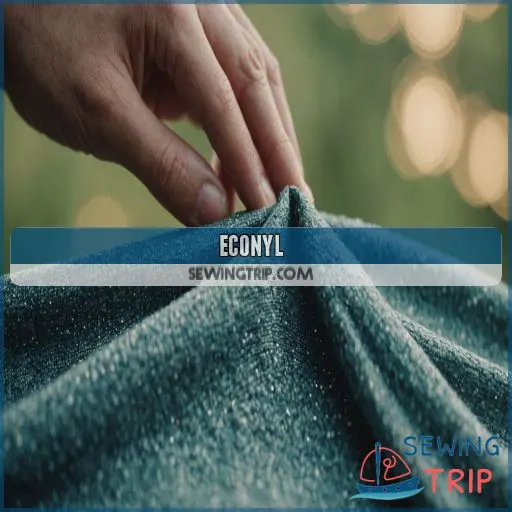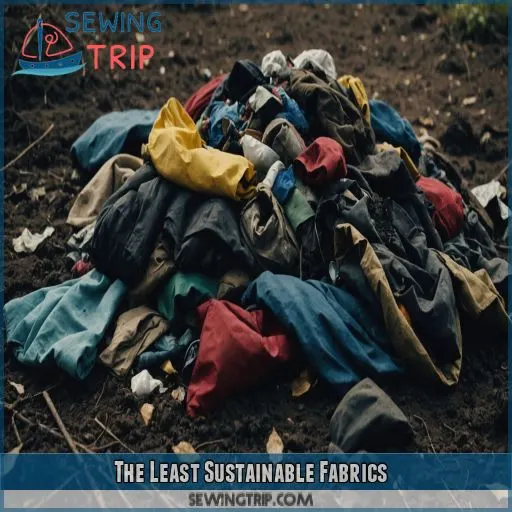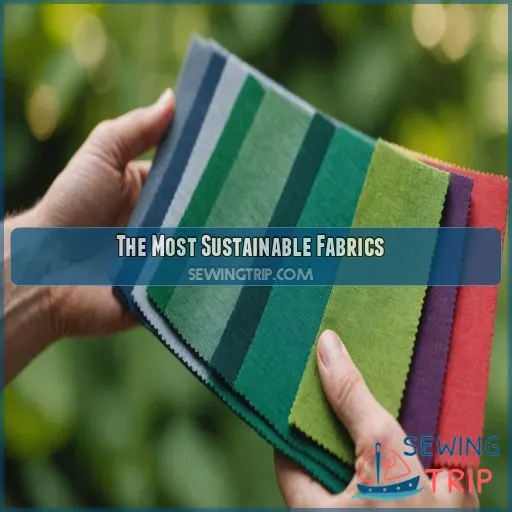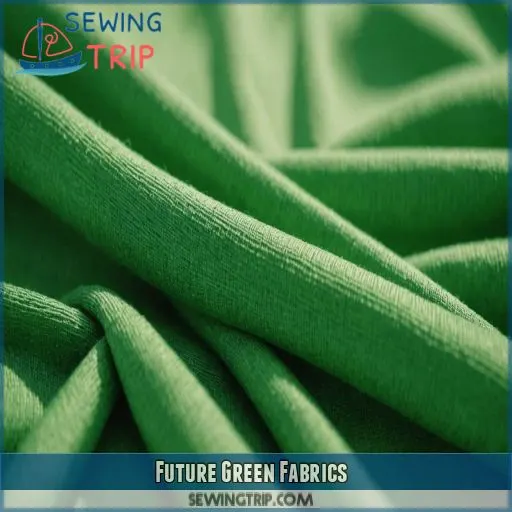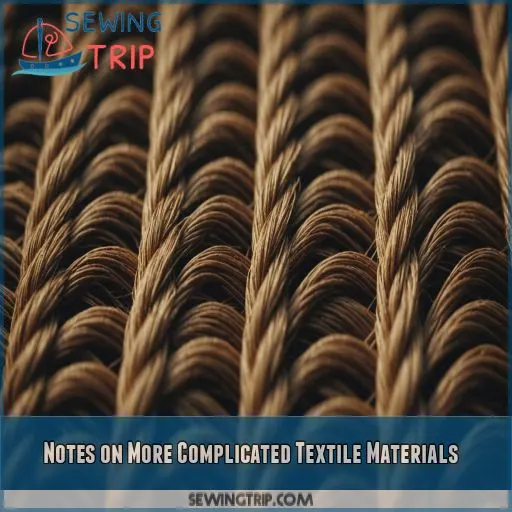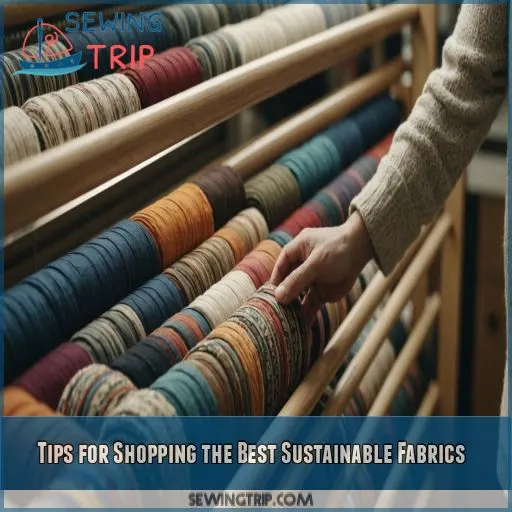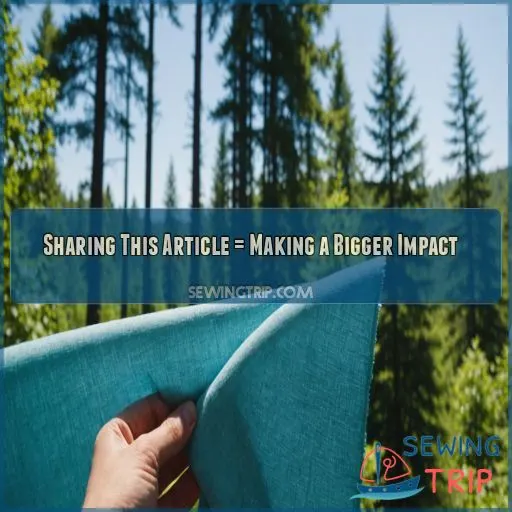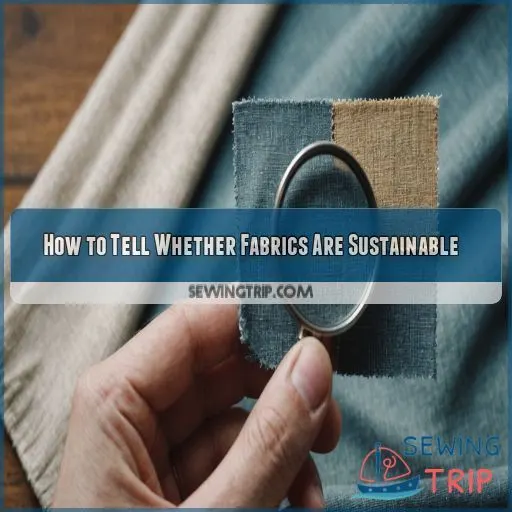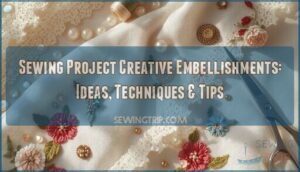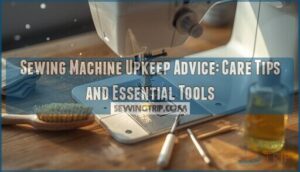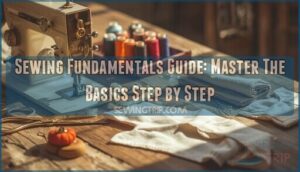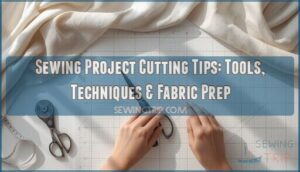This site is supported by our readers. We may earn a commission, at no cost to you, if you purchase through links.
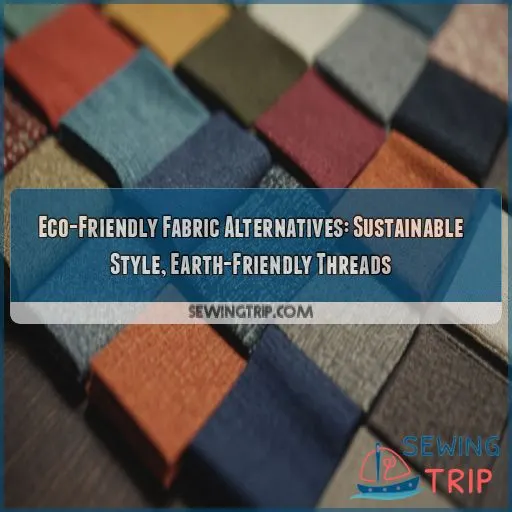
Ditch those pesky polyesters and acrylics, and get cozy with organic cotton, hemp, and linen instead.
These earth-friendly fabrics are grown with love (and fewer chemicals), requiring less water and pesticides than their conventional counterparts.
You’ll be rocking sustainable threads in no time!
But, what makes these fabrics so special?
And what other eco-friendly options are out there?
Let’s explore sustainable fabrics and get you looking – and feeling – great!
Table Of Contents
- Key Takeaways
- ECONYL
- The Least Sustainable Fabrics
- The Most Sustainable Fabrics
- Future Green Fabrics
- Notes on More Complicated Textile Materials
- Tips for Shopping the Best Sustainable Fabrics
- Sharing This Article = Making a Bigger Impact
- How to Tell Whether Fabrics Are Sustainable
- Frequently Asked Questions (FAQs)
- Conclusion
Key Takeaways
- You’re not alone in the struggle to find sustainable fabrics – and now you know what to look for. Ditch those pesky polyesters and acrylics, and get cozy with organic cotton, hemp, and linen instead. These earth-friendly fabrics are grown with love (and fewer chemicals), requiring less water and pesticides than their conventional counterparts.
- When shopping for sustainable fabrics, keep an eye out for certifications like GOTS (Global Organic Textile Standard) and Oeko-Tex, which guarantee that textiles meet rigorous environmental and social standards. Think of these labels as a seal of approval for your sustainable style choices.
- Sustainable fabrics aren’t just good for the planet – they’re also good for your skin. Choose eco-friendly materials like organic cotton, hemp, and Tencel, which reduce waste and minimize environmental impact. Plus, they’re breathable, durable, and gentle on your skin.
- You don’t have to sacrifice style for sustainability. From Piñatex (a vegan leather alternative made from pineapple leaves) to Qmonos (a synthetic spider silk fabric that’s biodegradable and cruelty-free), there are tons of innovative, eco-friendly fabrics that are redefining the possibilities of sustainable fashion.
ECONYL
ECONYL is a sustainable superstar, a recycled nylon that gives new life to ocean plastic, abandoned fishing nets, and fabric scraps. It’s a versatile fabric, offering an eco-conscious alternative to virgin nylon in everything from activewear to carpets.
Lyocell
You’re on the hunt for sustainable fabrics, and Lyocell‘s caught your eye! Made from wood pulp, it’s a game-changer. Here’s what you need to know:
- Lyocell production uses a closed-loop system, minimizing waste and emissions.
- Tencel and Lyocell are basically the same thing – just different brand names!
- Lyocell beats rayon in the sustainability stakes, hands down.
- Brands like Patagonia and Reformation love using Lyocell in their clothing lines.
- To care for Lyocell, just wash it cold and hang it to dry – easy peasy!
Sheep Wool
Sheep wool is a natural, biodegradable fabric with a sustainable reputation.
But, there are some ethical considerations.
Merino wool, for instance, often involves mulesing, a controversial practice with animal welfare concerns.
So, when choosing sheep wool, prioritize ethical sourcing and regenerative farming practices.
Look for organic certifications and ask about animal treatment.
The Least Sustainable Fabrics
Some fabrics are more harmful to the environment than others. We’ll show you the least sustainable fabrics and why they’re not-so-eco-friendly, so you can make informed choices and give those fabrics a hard pass.
Fabrics to Avoid: Polyester
Polyester: It’s Complicated, and Not in a Good Way
You want to steer clear of polyester. It’s derived from oil, a major polluter, and it sticks around for way too long—20 to 200 years! That’s way too much baggage for your wardrobe. Plus, it’s a microplastics offender, shedding tiny plastic bits with every wash. Those microplastics end up in our oceans, and, well, it’s just not cool. Opt for polyester alternatives like recycled polyester or biodegradable fabrics instead.
Unsustainable Fabrics: Acrylic
Acrylic is another fabric to steer clear of on your sustainable journey.
Its production involves a bunch of toxic chemicals, including acrylonitrile, which isn’t great for your health.
It’s not easily recycled and sticks around for up to 200 years.
Plus, it’s a big contributor to microplastic pollution in our oceans.
Cotton (Conventional)
- Water-guzzling: Cotton farming drains water sources, affecting ecosystems.
- Pesticide-heavy: Cotton farming relies on toxic chemicals, harming soil and wildlife.
- Textile waste: Conventional cotton contributes to the staggering 15 million tons of textile waste in the US each year.
- Unfair labor: Conventional cotton often involves unethical labor practices, exploiting workers.
Opt for sustainable alternatives like organic or recycled cotton instead!
Rayon (aka Viscose)
You might think rayon (aka viscose) is a natural, eco-friendly fabric. But hold on! Rayon production involves intense chemical processes that release harsh chemicals into the environment. Let’s break it down:
| Fabric | Production Process | Environmental Impact | Sustainable Alternative |
|---|---|---|---|
| Rayon | Chemical-intensive | Deforestation, pollution | Lyocell, Bamboo viscose |
| Viscose | Wood pulp treatment | Harsh chemical release | Recycled fabrics, Organic cotton |
| Semi-synthetic | Blended materials | Microplastic pollution | Biodegradable fabrics, Tencel |
| Bamboo viscose | Mechanically processed | Lower environmental impact | Closed-loop production, Organic bamboo |
Look for sustainable rayon alternatives like Lyocell or bamboo viscose to reduce your environmental footprint.
Synthetic Fabric: Nylon
You’re probably no stranger to nylon – it’s in your outdoor gear, activewear, and even some carpets. But here’s the thing: nylon production is a major polluter. Time to think about some nylon alternatives!
- Recycled nylon: Made from ocean plastic, it’s a game-changer.
- Econyl: Another recycled nylon option that’s durable and sustainable.
- Deadstock fabric: Reduces waste and minimizes environmental impact.
- Sustainable activewear: Opt for brands that use eco-friendly materials.
The Most Sustainable Fabrics
When you upgrade your wardrobe with eco-friendly fabrics, you’re doing more than just reducing your environmental impact. You’re also investing in your own values. Here are some sustainable fabrics that are as gentle on the planet as they’re on your skin: organic cotton, hemp, linen, Tencel, and recycled polyester. They’re all game-changers in sustainable fashion.
Organic Cotton or Recycled Cotton Fabric
Looking for sustainable cotton? You have two great options: organic cotton and recycled cotton. Organic cotton is grown without harsh chemicals, while recycled cotton helps reduce textile waste. To make sure you’re getting the good stuff, look for GOTS certification. Both options are gentler on the planet, and with proper care, they’ll stay soft and cozy for a long time.
Organic Hemp Fabric
You’re searching for a sustainable superstar fabric? Check out organic hemp! This durable, versatile fabric needs minimal water and pesticides to grow, making it a more eco-friendly choice than cotton. Plus, hemp fabric is breathable, UV-resistant, and gets softer with each wash. When shopping for hemp clothing, choose brands with GOTS certification to guarantee sustainable practices.
Organic Linen Fabric
You’re exploring eco-friendly fabrics, and organic linen is a superstar! It’s breathable and light, and it’s also biodegradable and requires minimal water and pesticides. Here are a few fun facts about organic linen:
- Linen vs. Cotton: Linen is more durable and absorbs moisture better.
- Linen Care: Simply wash in cold water and line dry.
- Linen Production: Look for GOTS certification for sustainable practices.
Tencel Lyocell Fabric
Let’s talk Tencel Lyocell fabric. This eco-friendly alternative is made from wood pulp and boasts impressive durability. Unlike Rayon, Tencel’s closed-loop production process recycles 99% of water and solvents, making it a top choice for sustainable fashion. Look for brands that incorporate Tencel into their designs, and enjoy the comfort and style of plant-based fabrics.
Recycled Polyester (rPET) Fabric
You’re looking for a sustainable fabric that’s as reliable as your favorite workout buddy! Recycled Polyester (rPET) is here to save the day. Made from plastic bottles, it reduces waste and conserves resources. Here’s the lowdown:
- rPET production process: plastic bottles are collected, sorted, and transformed into flakes, then spun into yarn.
- rPET vs virgin polyester: reduces energy consumption by 35% and conserves 70% of water.
- rPET fabric durability: just as tough as virgin polyester, but with a clearer conscience!
Future Green Fabrics
When you start exploring sustainable fabrics, you’ll be excited to discover the innovative materials that are changing the game – and the planet – for the better. From Piatex, a vegan leather alternative made from pineapple leaves, to Qmonos, a synthetic spider silk fabric that’s biodegradable and cruelty-free, these future green fabrics are redefining the possibilities of eco-friendly fashion.
Piatex
You’re looking for a vegan alternative to traditional leather? Enter Piatex, a game-changing fabric made from pineapple leaves! It’s cruelty-free and it’s also incredibly durable and stylish. Plus, it’s produced using a closed-loop system, minimizing waste and environmental impact.
| Piatex Benefits | Traditional Leather | Piatex |
|---|---|---|
| Cruelty-Free | No | Yes |
| Durability | Medium | High |
| Sustainability | Low | High |
| Style | Classic | Modern, versatile |
Qmonos
You’re about to meet Qmonos, the game-changing synthetic spider silk fabric. This biodegradable wonder has similar properties to nylon and silk, but without the environmental guilt. Imagine wearing clothes that are both stylish and sustainable! Qmonos production is still in its early stages, but it’s already making waves in the sustainable fashion industry as a GOTS-certified, eco-friendly alternative.
Notes on More Complicated Textile Materials
You’re probably thinking, "Wait, what about those fabrics that don’t fit neatly into the sustainable or not-so-sustainable categories?" Let’s tackle those tricky textile materials that require a closer look, like bamboo, leather, wool, modal, and cupro, to help you make informed choices for your wardrobe and the planet.
Is Bamboo an Eco Friendly Fabric?
Bamboo can be tricky. While bamboo plants are super sustainable, the process of turning them into fabric can be a real environmental drag, especially if it involves harsh chemicals (Source). Look for certifications like GOTS or Oeko-Tex to make sure your bamboo fabric is made with eco-friendly methods.
Is Leather Eco-Friendly?
Leather – the ultimate fashion conundrum. You love the look, but is it eco-friendly? Sadly, traditional leather production is a resource-intensive process with a significant environmental impact. However, there are alternatives: vegan leather, upcycled leather, and vegetable-tanned leather are more sustainable options. Look for cruelty-free fabrics and sustainable leather to upgrade your wardrobe with a clear conscience.
Is Wool Good for the Environment?
Wool can be tricky. Wool farming practices can hurt the environment and animals if they aren’t done responsibly. Look for brands that make sure their wool is sourced ethically, like those using regenerative agriculture methods. Some sheep breeds are also more sustainable than others. Look for GOTS certification to make sure your wool is sourced with care.
Is Cellulose Fabric Modal Good for the Planet?
Now that we’ve talked about wool, let’s tackle Modal, another fabric with an eco-friendly reputation. Modal production relies on beech tree pulp, but its chemical-heavy process raises concerns. Is Modal good for the planet? Not entirely. Here are some things to keep in mind:
- The demand for Modal has led to beech tree monocultures, harming biodiversity.
- Chemical use in Modal production can harm workers and the environment.
- Look for alternative materials like Ecovero, which uses more sustainable sourcing and production methods.
How Sustainable is Cupro?
Let’s get real about Cupro. This silky fabric is made from cotton linter, a byproduct of cotton production. Here’s the lowdown:
| Cupro Benefits | Cupro Drawbacks |
|---|---|
| Soft, breathable, and gentle on skin | Energy-intensive production process |
| Biodegradable and compostable | May not be as durable as other fabrics |
| Can be made from recycled materials | Limited availability and higher cost |
Is Cupro worth it? If you value softness and sustainability, yes. But if you prioritize durability and affordability, you might want to explore other eco-friendly fabric alternatives.
Tips for Shopping the Best Sustainable Fabrics
Shopping for sustainable fabrics can be overwhelming, but with a few simple tips, you’ll be on your way to an eco-friendly wardrobe. When browsing through stores or online, look for sustainable brands that prioritize eco-conscious practices. Check the fabric labels for certifications like GOTS (Global Organic Textile Standard) or Oeko-Tex, which guarantee the use of sustainable materials and responsible manufacturing processes.
Here are some tips to get you started:
- Shop secondhand first: You’ll reduce waste and find unique, one-of-a-kind pieces.
- Check the labels: Look for sustainable fabrics, deadstock, or compostable materials.
- Research eco-conscious brands: Learn about their sourcing, manufacturing, and waste management practices to make sure they match your values.
Sharing This Article = Making a Bigger Impact
Hey, friend! Now that you’re equipped with the knowledge of sustainable fabrics, it’s time to spread the word. Sharing this article with your friends and family can make a bigger impact than you think. By sharing, you’re contributing to a collective effort to promote eco-conscious choices and sustainable fashion.
| Your Action | The Impact | The Result |
|---|---|---|
| Share this article | Inspire others to make sustainable choices | More people choosing eco-friendly fabrics |
| Support sustainable brands | Encourage companies to adopt sustainable practices | A more sustainable supply chain |
| Choose GOTS certified products | Promote fair trade and cradle to cradle practices | A fairer, more sustainable fashion industry |
How to Tell Whether Fabrics Are Sustainable
You’re probably wondering how to tell whether fabrics are sustainable.
After all, it’s not like they come with a big green stamp of approval (although, wouldn’t that be awesome?).
To make informed choices, you’ll want to look for certifications like Fairtrade Certified, Cradle to Cradle, GOTS Certified, Made in Green, and Oeko-tex.
These certifications guarantee that the fabric meets certain standards for environmental and social responsibility.
Fairtrade Certified
Now that we’ve talked about sharing the article, let’s get into how to spot sustainable fabrics. When you see the Fairtrade Certified label, you know the fabric meets rigorous standards for worker rights, sustainable farming, and environmental impact. Here are 4 key things to know about Fairtrade Certified fabrics:
- Fair prices: Farmers get a fair deal for their crops.
- Sustainable farming: Practices that reduce environmental impact.
- Worker rights: Safe working conditions and fair labor practices.
- Community investment: A percentage of sales goes back to the community.
Cradle to Cradle
You’re on a mission to greenify your wardrobe. "Cradle to Cradle" is your new BFF – a philosophy that’s all about designing fabrics for a circular economy. It’s like Mother Nature’s own recycling program. Look for fabrics made with closed-loop systems, upcycling, and biomimicry. This means zero waste, sustainable disposal, and a clear conscience.
GOTS Certified
When shopping for sustainable fabrics, look for the GOTS (Global Organic Textile Standard) certification. It means that textiles meet strict environmental and social standards. GOTS certification guarantees that at least 70% of the fabric is made from organic fibers, and it covers everything from clothing to home textiles. Think of GOTS as a seal of approval for your sustainable style choices.
Made in Green
Now that you’re familiar with GOTS certification, let’s explore another eco-label: Made in Green. This label guarantees that the entire production process, from sourcing to manufacturing, meets rigorous environmental and social standards. Here are some key benefits:
- Transparency in the supply chain
- Ethical sourcing of materials
- Reduced environmental impact
- Guaranteed sustainable production processes
Oeko-tex
When shopping for sustainable fabrics, keep an eye out for the Oeko-Tex certification.
This label guarantees that textiles have been tested for harmful chemicals and meet rigorous safety standards.
It’s like having a guardian angel for your skin and the planet!
Look for Oeko-Tex alongside other eco-friendly labels like GOTS certified and Made in Green for ultimate sustainability peace of mind.
Frequently Asked Questions (FAQs)
What is an eco-friendly fabric?
Imagine your closet as a garden – you want to nurture it with sustainable choices. An eco-friendly fabric is your green thumb, made from organic, recycled, or repurposed materials that reduce waste and minimize environmental harm.
What fabric is best for the environment?
You’re looking for the best fabric for the environment? Opt for organic hemp, organic linen, or Tencel Lyocell – they’re durable, biodegradable, and produced with minimal water and pesticides (Source).
What is the most ethical and sustainable fabric?
The most ethical and sustainable fabric is often a tie between organic hemp, organic linen, and recycled materials like ECONYL or rPET. You get to choose which one aligns with your values and style!
What are eco-friendly materials to make clothes?
You can opt for eco-friendly materials like organic cotton, hemp, recycled polyester, and Tencel, which reduce waste and minimize environmental impact. When shopping, look for certifications like GOTS and Oeko-Tex to show that sustainable practices are being used.
What are the benefits of using sustainable fabric alternatives?
By choosing sustainable fabric alternatives, you’re reducing your environmental footprint and also gaining durable, breathable, and comfortable clothing that’s gentle on your skin – it’s a win-win for you and the planet!
How do sustainable fabrics reduce environmental impact compared to conventional fabrics?
Imagine swapping your polyester workout clothes for a pair made from recycled ocean plastic, like ECONYL. By choosing sustainable fabrics, you’re reducing your environmental impact by conserving water, decreasing chemical use, and lowering greenhouse gas emissions.
What certifications ensure the authenticity of sustainable and recycled fabrics?
When shopping for sustainable fabrics, look for certifications like Global Recycle Standard (GRS) and Recycled Content Standard (RCS).
These certifications ensure the authenticity and sustainability of recycled fabrics, giving you confidence in your eco-friendly choices.
Can sustainable fabrics be as durable and long-lasting as conventional fabrics?
You’ll be surprised to know thatYou can enjoy the same durability and longevity with sustainable fabrics as you do with conventional ones! Choose high-quality options like organic hemp, Tencel, or recycled polyester, which are made to last and reduce waste (Source).
How does the production process of sustainable fabrics impact the environment?
A million thanks for considering sustainable fabrics! When you choose eco-friendly fabrics, their production process can really make a difference in reducing environmental impact by using organic farming, recycling materials, and minimizing waste, making the planet breathe a sigh of relief.
Conclusion
Imagine the impact of ditching 11 million tons of clothing waste in the US each year – it’s like clearing the Empire State Building of trash over 30 times!
You’ve taken the first step toward a more sustainable wardrobe by exploring eco-friendly fabric alternatives.
Now, go ahead and make a statement with organic cotton, hemp, and linen.

